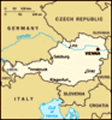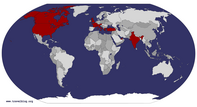Advertisement
Published: July 19th 2008
As the Eurorail got closer to Vienna, I looked out the window and noticed that the sky was grey and muggy, a symbol of upcoming rain. Our coupe mates, Arnold and Naomi invited us to their house if it rained too hard and we had nothing to do. We hoped it wouldn’t rain, thanked them for the invitation and took down their address and phone number. It was their daughter Asia’s 3rd birthday and we all sang her a happy birthday in the train as she ate a jelly sandwich (that Euro rail served for breakfast) and her 6 month old brother Jordan couldn’t stop grinning.
We got out of the Sudbahnof station at 9 am and sure enough it was drizzling. We were really upset as we didn’t want rain to spoil our day in Vienna. Sporting on a positive attitude and deciding to check out the Schonnbrunn Palace, we boarded a tram and got into a conversation with American students who were touring Austria and their enthusiasm bettered our moods. I felt that American students had the most fun in Europe, because they roamed around aimlessly like vagabonds, without reservations or itineries and learnt valuable lessons enroute. I
was sure that Niki would love to experience Europe when she got older and I would certainly encourage her to.
Having experienced three great European empires - the British, the French and the Roman, I was looking forward to get a taste of the Habsburg empire in Austria as well, and check out the childhood home of Marie Antoinette, who had somehow become a heroine to me right from my history text-book days.
The Schonnbrunn Palace, a Baroque architecture, was much simpler in grandeur than Versailles or the Windsor Castle. Given as a gift to Empress Maria Theresa by her father, the Palace was the Imperial Home of the Habsburg Empire. At age 6, Mozart performed in the Hall of Mirrors (a miniature of Versailles) in the presence of Maria Theresa and enchanted the Imperial family. After the concert, he jumped onto her lap, hugged her and smothered her with kisses. It later became the home of Emperor Franz Josef and Empress Elisabeth (Sisi). We were not allowed to take photos inside the palace. As we walked from room to room, listening to the audio guide, we could fathom the everyday royal life of the Habsburgs. While Versailles
was filled with golden glitz, the Schonbrunn palace had a Rococo charm with cream background, gold edgings, walnut paneling and rich Austrian chandeliers. No photographs inside!
Emperor Franz Joseph was a man with simple tastes. His bedroom had the basic necessities; his study was decorated with photographs of his ancestors and children. Empress Sisi, was a legend and well known rebel in the royal family as she had difficulty adapting to the strict etiquette practiced at the Habsburg court. Sisi not only became known for her beauty, but also for her fashion sense, diet and exercise regimens, her passion for riding sports and traveling extensively, as well as a series of reputed lovers. She paid extreme attention to her appearance and would spend most of her time preserving her beauty. It was interesting to see her dressing room and vanity. The grand dining rooms with silver service sets, the ballrooms, salons, galleries and hand made tapestries were absolutely gorgeous.
The Children’s room had portraits of Maria Theresa’s 11 daughters, who were all married off for different political reasons. Marie Antoinette was her youngest daughter, married to Louis XVI of France. The palace also houses a children’s museum where
costumes worn by the royal children are displayed. We peeked at the Palace gardens from the windows; they were beautiful but no match for Versailles and so we decided to skip them. As we stepped out of the Palace, the sky had cleared and the sun was coming out. We requested a British gentleman to take a picture of us in front of the palace and he obliged. We stood chatting for a while and learnt that he was a cricket trainer in England. He asked Rajesh if he missed cricket in the US and Rajesh told him that he did follow cricket and even played for the local university sometimes.
The next on my list was to check out the Naschmarkt, a Viennese market dating back to the 16th century. Naschmarkt was a unique mixture of Austrian traditions and oriental influences. This was the place to buy fresh produce, observe local life, or browse through the bric-a-brac at the flea market. Chefs cluttered the market trying to find specialties for the day’s menu. We browsed around the market buying peaches and plums and walked through the flea market looking at antiques and trinkets. Fast food places sold Pizzas,
Kebaps and Falafel. We ate Chicken Kebap wraps and the luscious fruits we bought sitting on a bench along the Wienzeile.
Austria was by far the cheapest country compared to Italy and France. Lunch for both of us cost just E7.50 with soda. The unlimited travel pass for a day was E5.70 each. Encouraged by this fact, after lunch, we decided to go shopping and headed out to Mariahilfer Strasse, Vienna’s most important shopping mile filled with all kinds of branded stores. We hopped from store to store and Rajesh bought a pair of trendy European shoes at Ludwig Reiter and immediately put it on. To me, he looked like someone in-between Arnold Schwarzenegger and Wall Street stockbrokers.
Tired after shopping, we took the tram to Vienna’s Old Town. As we got out of the tram, St. Stephen’s cathedral loomed in front of us. Located in Stephensplatz, it is a beautiful Romanesque Gothic church. The main entrance to the church is named the Giant's Door. A glory of St. Stephen's Cathedral is its ornately patterned, richly colored roof, covered by glazed tiles. Above the choir, the tiles form a mosaic of the double-headed eagle that is symbolic of
the Habsburg dynasty that ruled Austria. The inner sanctum was peaceful and we sat there for a while admiring the architecture and the stained glass.
Dessert is Vienna's fast food. Every couple of hours we stopped at Viennese Kaffeehauses and bought rich crème cakes and fruit tortes. I tried the Viennese coffee - Mélange, which is half coffee and half milk and very likeable by the Indian palate. We sat on a bench outside St. Stephen’s cathedral and watched the people dressed in Mozart era costumes sell concert tickets to the tourists. Slowly savoring Apfelstrudel(apple strudel), we got immersed in Vienna’s kaleidoscopic culture and I felt as if Emperor Franz Josef or Mozart would come round the corner any minute.
In no other city in the world have so many world-renowned musicians and composers made their home. A brochure invited us to walk through the memorials of Mozart, Beethoven, Strauss and many more. We decided to check out Mozart’s memorial, the Mozarthaus. In Vienna, apartments of famous composers have been turned into museums. You can see the furniture and objects that were owned by the artists themselves, as well as paintings and photos. The most important works by
the composers can be listened to with earphones. After a taste of Mozart’s symphony, we took a tram to go around the Ringstrasse, the grand boulevard that surrounds the city.
The Ringstrasse is certainly Vienna in all its grandeur and centuries-old splendor.The street was built in the 19th century to replace the city walls, which had been built during the 13th century. Tram # 1 and 2 both go around the Ringstrasse, in opposite directions. We did couple of loops around the impressive boulevard in the tram, feasting our eyes on the palatial buildings, passing the Opera House, the Parliament Building, the Imperial Palace and numerous museums and churches. We got out of the tram by the River Danube and walked past Karntner Strasse onto the Hoffburg treasury of jewels and Empress Sisi’s museum. We did not go in since I had had enough, seeing the crown jewels of Queen Elizabeth in London. But I was totally bowled over by the grand buildings and the history and heritage that oozed out of it.
“The Golden U”, the area around Kohlmarkt, Graben and Karntner Strasse, has been a luxury thoroughfare since imperial days. Walking through the Golden U, I
felt like Empress Sisi with no money. We passed the crafted exquisite Lobmeyr showroom where every hand-blown piece of Lobmeyr glass is unique, and wealthy clientele can even have custom drinking glasses and crystal chandeliers made. Jewelry by A.E. Kochert once graced Empress Sisi. The modern version of Sisi’s diamond studded star hairpins was sold as pendants, rings and earrings. We stopped at Demel, Empress Sisi’s favorite confectionery for our last pastry of the day.
In Vienna, the locals spoke German. Strasse means street and Platz means square. Ausgang meant Exit and autobahn meant Highway. The Belvedere palace lay close to our bahnof (train station). Since we had some time to kill, before retreating to our hotel, we decided to check it out. The Belvedere Palace was built by the Prince of Savoy. The garden was laid out, enclosed by clipped hedging, in the formal French manner with graveled walks. A great water basin lay in front of the palace with stairs and cascades peopled by nymphs and Greek goddesses. The Palace was closed; but anyway we didn’t want to go in. Locals walked and jogged around the water basin. We circled around the palace and sat on the
steps and wished it was mine!
One thing I would have loved to do in Vienna, but missed due to time constraint was to attend a Viennese ball-room waltz that the city is famous for. The Viennese Waltz consists of clock-wise and anti-clockwise turns and change steps and I have watched it on TV; it was beautiful with the men in tuxedos and the slim-waisted women in gorgeous ballgowns. Next time, perhaps! My mom had said that we would love Vienna and she was so right! I could tell that Rajesh was smitten with the city and so was I, totally captivated by its grandeur.
Advertisement
Tot: 0.084s; Tpl: 0.013s; cc: 11; qc: 52; dbt: 0.0476s; 1; m:domysql w:travelblog (10.17.0.13); sld: 1;
; mem: 1.2mb



















